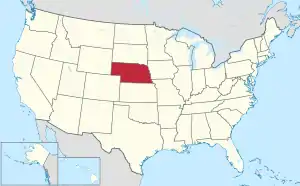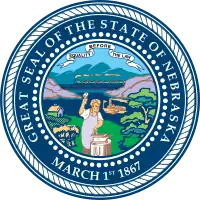Keith County, Nebraska
Keith County is a county in the U.S. state of Nebraska. As of the 2010 United States Census, the population was 8,368.[1] Its county seat is Ogallala.[2]
Keith County | |
|---|---|
 Keith County Courthouse in Ogallala | |
 Location within the U.S. state of Nebraska | |
 Nebraska's location within the U.S. | |
| Coordinates: 41°12′N 101°40′W | |
| Country | |
| State | |
| Founded | 1873 |
| Named for | Keith Neville |
| Seat | Ogallala |
| Largest city | Ogallala |
| Area | |
| • Total | 1,110 sq mi (2,900 km2) |
| • Land | 1,062 sq mi (2,750 km2) |
| • Water | 48 sq mi (120 km2) 4.3%% |
| Population | |
| • Estimate (2018) | 8,021 |
| • Density | 7.6/sq mi (2.9/km2) |
| Time zone | UTC−7 (Mountain) |
| • Summer (DST) | UTC−6 (MDT) |
| Congressional district | 3rd |
| Website | www |
In the Nebraska license plate system, Keith County is represented by the prefix 68 (it had the sixty-eighth-largest number of vehicles registered in the county when the license plate system was established in 1922).
History
Keith County was formed in 1873. Sources differ on the Keith after whom it was named: either M. C. Keith of North Platte, whose grandson Keith Neville became Nebraska's 18th governor in 1917; or John Keith, also of North Platte.[3][4]
Geography
The terrain of Keith County consists of low rolling hills. The level areas are used for agriculture, mainly in the lower part of the county. The North Platte River flows eastward into the northwest end of the county, feeding Lake McConaughy, then exiting the county's east line near its midpoint. The South Platte River flows eastward into the southwest end of the county, and crosses the lower central part of the county before exiting to the east, headed for its junction with the North Platte River well to the east of Keith County.[5]
The county has an area of 1,110 square miles (2,900 km2), of which 1,062 square miles (2,750 km2) is land and 48 square miles (120 km2) (4.3%) is water.[6]
Most of Nebraska's 93 counties (the eastern 2/3) observe Central Time; the western counties observe Mountain Time. Keith County is the easternmost of the Nebraska counties to observe Mountain Time.[7]
Major highways
Adjacent counties
- Arthur County – north
- McPherson County – northeast (boundary of Central Time)
- Lincoln County – east (boundary of Central Time)
- Perkins County – south
- Deuel County – west
- Garden County – northwest
Demographics
| Historical population | |||
|---|---|---|---|
| Census | Pop. | %± | |
| 1880 | 194 | — | |
| 1890 | 2,556 | 1,217.5% | |
| 1900 | 1,951 | −23.7% | |
| 1910 | 3,692 | 89.2% | |
| 1920 | 5,294 | 43.4% | |
| 1930 | 6,721 | 27.0% | |
| 1940 | 8,333 | 24.0% | |
| 1950 | 7,449 | −10.6% | |
| 1960 | 7,958 | 6.8% | |
| 1970 | 8,487 | 6.6% | |
| 1980 | 9,364 | 10.3% | |
| 1990 | 8,584 | −8.3% | |
| 2000 | 8,875 | 3.4% | |
| 2010 | 8,368 | −5.7% | |
| 2018 (est.) | 8,021 | [10] | −4.1% |
| U.S. Decennial Census[11] 1790-1960[12] 1900-1990[13] 1990-2000[14] 2010-2013[1] | |||
As of the census[15] of 2000, there were 8,875 people, 3,707 households, and 2,535 families residing in the county. The population density was 8 people per square mile (3/km2). There were 5,178 housing units at an average density of 5 per square mile (2/km2). The racial makeup of the county was 96.75% White, 0.08% Black or African American, 0.71% Native American, 0.17% Asian, 1.49% from other races, and 0.80% from two or more races. 4.23% of the population were Hispanic or Latino of any race.
There were 3,707 households, out of which 30.20% had children under the age of 18 living with them, 58.60% were married couples living together, 7.00% had a female householder with no husband present, and 31.60% were non-families. 27.90% of all households were made up of individuals, and 13.50% had someone living alone who was 65 years of age or older. The average household size was 2.37 and the average family size was 2.89.
In the county, the population was spread out, with 25.30% under the age of 18, 5.70% from 18 to 24, 25.30% from 25 to 44, 25.40% from 45 to 64, and 18.40% who were 65 years of age or older. The median age was 41 years. For every 100 females there were 96.50 males. For every 100 females age 18 and over, there were 92.80 males.
The median income for a household in the county was $32,325, and the median income for a family was $39,118. Males had a median income of $26,523 versus $19,024 for females. The per capita income for the county was $17,421. About 6.60% of families and 9.30% of the population were below the poverty line, including 13.10% of those under age 18 and 8.20% of those age 65 or over.
Communities
City
- Ogallala (county seat)
Politics
| Year | Republican | Democratic | Third Parties |
|---|---|---|---|
| 2016 | 80.2% 3,235 | 14.2% 571 | 5.7% 228 |
| 2012 | 75.0% 3,044 | 22.9% 928 | 2.1% 86 |
| 2008 | 74.1% 2,942 | 24.6% 974 | 1.3% 52 |
| 2004 | 81.1% 3,356 | 18.0% 743 | 0.9% 38 |
| 2000 | 76.7% 2,953 | 20.2% 778 | 3.1% 118 |
| 1996 | 65.5% 2,504 | 21.7% 830 | 12.8% 489 |
| 1992 | 51.7% 2,050 | 18.6% 740 | 29.7% 1,179 |
| 1988 | 72.3% 2,886 | 26.9% 1,075 | 0.8% 30 |
| 1984 | 84.1% 3,433 | 15.5% 631 | 0.4% 18 |
| 1980 | 77.7% 3,381 | 16.3% 710 | 6.0% 263 |
| 1976 | 66.1% 2,485 | 30.3% 1,139 | 3.6% 136 |
| 1972 | 79.1% 2,513 | 20.9% 665 | |
| 1968 | 70.9% 2,126 | 23.2% 694 | 5.9% 178 |
| 1964 | 51.9% 1,927 | 48.1% 1,784 | |
| 1960 | 68.9% 2,680 | 31.1% 1,211 | |
| 1956 | 73.8% 2,624 | 26.2% 930 | |
| 1952 | 78.4% 2,790 | 21.6% 769 | |
| 1948 | 59.1% 1,600 | 40.9% 1,109 | |
| 1944 | 60.3% 1,739 | 39.7% 1,147 | |
| 1940 | 53.5% 2,022 | 46.5% 1,759 | |
| 1936 | 34.7% 1,094 | 63.5% 2,000 | 1.8% 58 |
| 1932 | 31.6% 946 | 67.2% 2,009 | 1.2% 36 |
| 1928 | 67.1% 1,715 | 32.6% 832 | 0.4% 9 |
| 1924 | 49.9% 1,069 | 28.1% 602 | 22.0% 470 |
| 1920 | 64.7% 1,050 | 29.1% 472 | 6.2% 100 |
| 1916 | 39.1% 389 | 54.6% 544 | 6.3% 63 |
| 1912 | 23.0% 188 | 37.3% 304 | 39.7% 324[19] |
| 1908 | 53.4% 368 | 45.0% 310 | 1.6% 11 |
| 1904 | 60.2% 263 | 20.4% 89 | 19.5% 85 |
| 1900 | 52.3% 246 | 46.0% 216 | 1.7% 8 |
References
- "State & County QuickFacts". US Census Bureau. Retrieved September 21, 2013.
- "Find a County". National Association of Counties. Archived from the original on 31 May 2011. Retrieved 7 June 2011.
- Fitzpatrick, Lilian Linder (1925). "Nebraska Place-Names". University of Nebraska Department of English. p. 84. Retrieved 13 June 2013.
- "Governor Neville". Nebraska State Historical Society. Retrieved 13 June 2013.
- Keith County NE Google Maps (accessed 23 January 2019)
- "2010 Census Gazetteer Files". US Census Bureau. August 22, 2012. Archived from the original on November 13, 2013. Retrieved December 8, 2014.
- Map of Time Zone Line through Nebraska (accessed 22 January 2019)
- Clear Creek State Waterfowl Management Area, Lewellen NE Google Maps (accessed 23 January 2019)
- Lake Mcconaughy State Recreation Area and Wildlife Management Area Google Maps (accessed 23 January 2019)
- "Population and Housing Unit Estimates". Retrieved December 30, 2019.
- "U.S. Decennial Census". United States Census Bureau. Retrieved December 8, 2014.
- "Historical Census Browser". University of Virginia Library. Retrieved December 8, 2014.
- "Population of Counties by Decennial Census: 1900 to 1990". United States Census Bureau. Retrieved December 8, 2014.
- "Census 2000 PHC-T-4. Ranking Tables for Counties: 1990 and 2000" (PDF). United States Census Bureau. Retrieved December 8, 2014.
- "U.S. Census website". United States Census Bureau. Retrieved 2008-01-31.
- Megeath, Brule NE Google Maps (accessed 23 January 2019)
- Fitzpatrick, Lilian Linder (1925). "Nebraska Place-Names". University of Nebraska Dept. of English. pp. 84-85. Retrieved 30 September 2013.
- http://uselectionatlas.org/RESULTS
- The leading "other" candidate, Progressive Theodore Roosevelt, received 234 votes, while Socialist candidate Eugene Debs received 85 votes and Prohibition Eugene Chafin received 5 votes.
Further reading
- John Janovy Jr. "Keith County Journal" St. Martin's Press (1978)
- John Janovy Jr. "Yellowlegs: A Migration of the Mind" Houghton Mifflin Company (1980)
- John Janovy Jr. "Back in Keith County" University of Nebraska Press (1982)
